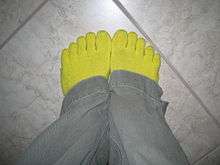Sock
A sock is a piece of clothing worn on the feet and often covering the ankle or some part of the calf. Some type of shoe or boot is typically worn over socks. In ancient times, socks were made from leather or matted animal hair. In the late 16th century, machine-knit socks were first produced. Until 1800 both hand knitting and machine knitting were used to produce socks, but after 1800, machine knitting became the predominant method.
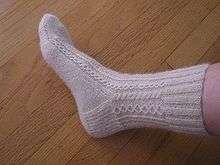
.png)
One of the roles of socks is absorbing perspiration. As the foot is among the heaviest producers of sweat in the body, it can produce over 0.25 US pints (0.12 l) of perspiration per day;[1] socks help to absorb this sweat and draw it to areas where air can evaporate the perspiration. In cold environments, socks made from cotton or wool helps warm up cold foot which in turn, helps decrease the risk of getting frostbite. Thin socks are most commonly worn in the summer months to keep feet cool. Light colored socks are typically worn with sports shoes and dark colored socks with dress shoes (often black or navy blue dress socks). In addition, dark colored socks absorbs heat which in turn helps keep the foot warm while light colored socks reflects heat which in turn helps the feet stay cool.
Etymology
The modern English word sock is derived from the Old English word socc, meaning "light slipper". This comes from the Latin soccus, a term to describe a "light, low-heeled shoe" worn by Roman comic actors,[2] and deriving from the Ancient Greek word sykchos.[3]
History

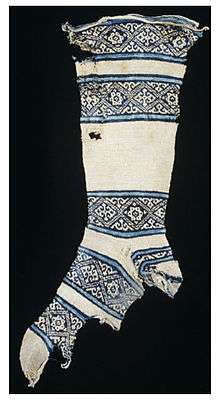
Socks have evolved over the centuries from the earliest models, which were made from animal skins gathered up and tied around the ankles. According to the Greek poet Hesiod, in the 8th century BC, the Ancient Greeks wore socks called "piloi", which were made from matted animal hair.[4] The Romans also wrapped their feet with leather or woven fabrics. Around the 2nd century AD, the Romans started sewing the fabrics together making fitted socks called "udones". By the 5th century AD, socks called "puttees" were worn by holy people in Europe to symbolize purity.
During the Middle Ages, the length of trousers was extended and the sock became a tight, brightly colored cloth covering the lower part of the leg. Since socks did not have an elastic band, garters were placed over the top of the stockings to prevent them from falling down. When breeches became shorter, socks began to get longer (and more expensive). By 1000 AD, socks became a symbol of wealth among the nobility. From the 16th century onwards, an ornamental design on the ankle or side of a sock has been called a clock.[5][6][7]
The invention of a knitting machine in 1589 meant that socks could be knitted six times faster than by hand. Nonetheless, knitting machines and hand knitters worked side by side until 1800.
The next revolution in sock production was the introduction of nylon in 1938. Until then socks were commonly made from silk, cotton and wool. Nylon was the start of blending two or more yarns in the production of socks, a process that still continues today.
Fabrication
Socks can be created from a wide variety of materials, such as cotton, wool, nylon, acrylic, polyester, olefins (such as polypropylene), or spandex.[8] To get an increased level of softness other materials that might be used during the process can be silk, bamboo, linen, cashmere, or mohair.[8] The color variety of sock choices can be any color that the designers intend to make the sock upon its creation. Sock 'coloring' can come in a wide range of colors. Sometimes art is also put onto socks to increase their appearance. Colored socks may be a key part of the uniforms for sports, allowing players teams to be distinguished when only their legs are clearly visible.
The township-level district of Datang in the city of Zhuji in Zhejiang Province, People's Republic of China, has become known as Sock City. The town currently produces 8 billion pairs of socks each year,[9] a third of the world's sock production, effectively creating two pairs of socks for every person on the planet in 2011.[10]
Styles
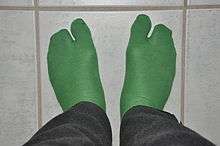
Socks are manufactured in a variety of lengths. No show, low cut, and ankle socks extend to the ankle or lower and are often worn casually or for athletic use. No show and/or low cut socks are designed to create the look of bare feet when worn with shoes (sock not visible). Knee-high socks are sometimes associated with formal dress or as being part of a uniform, such as in sports (like football and baseball) or as part of a school's dress code or youth group's uniform. Over-the-knee socks or socks that extend higher (thigh-high socks) are sometimes referred to as female garments in the common era. They were widely worn by children, both boys and girls, during the late 19th and early 20th centuries; although, the popularity varied widely from country to country.[11] When worn by adult females, knee-high or thigh-high socks can become the object of sexual attraction and fetishism by some men.[12]
Toe socks encases each toe individually the same way a finger is encased in a glove, while other socks have one compartment for the big toe and one for the rest, like a mitten; most notably what Japanese call tabi while other parts of the world simply call it tabi. Both of these allow one to wear flip-flops with the socks.[13] Leg warmers, which are not typically socks, may be replaced with socks in cold climates and are similar to leggings due to the fact that they typically only keep your legs warm in cold weather but not the entire foot.
A business sock or dress sock is a term for a dark colored sock (typically black or navy blue) for formal and/or casual footwear. It is often loosely referred to as a work sock or a formal sock for formal occasions, for example weddings, funerals, graduation ceremonies, prom, church, or work.
Crew socks are short and thick or thin everyday socks. Those socks are usually ribbed at the top of the ankles.[14][15] They can be used in a way to warm legs if pulled all the way up.[16] The first familiar practice of crew socks was in 1948. Crew socks are usually unisex.[17]
A low cut sock is a kind of sock that describe in a way to be cut below the ankle. Low cut socks are formed to cover the contours of a person's feet. Although the low cut socks are unisex, but women and girls commonly use them. Low cut socks are normally worn with shoes such as boat shoes, Oxfords, moccasins and loafers.
The Ancient Egyptian style of sock is a blend between modern Western socks and Japanese tabi, both of which it predates. Like tabi, Egyptian socks have one compartment for the big toe and another for the rest, permitting their use with sandals; like Western socks, they fit snugly to the foot and do not use fasteners like tabi.
Sizes
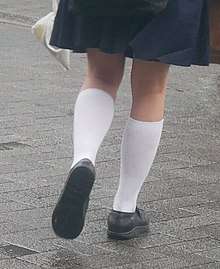
Although generally holding to a pattern of being divided into sizes of small-medium-large, etc., what range of shoe sizes those sock sizes correspond to carries in different markets.[18] Some size standards are coordinated by standard-setting bodies but others have arisen from custom.[19] Sock lengths vary, from ankle-high to thigh level.[20]
Sports
Most sports requires some sort of sock, usually a knee length or mid-calf sock to protect one's legs from being scraped while participating in sport activities. In basketball, tube socks are worn, and in lacrosse, mid-calf socks are required. In football, knee socks are used. They are mostly to stop grass burns.[21]
Other uses of the word
The layer of leather or other material covering the insole of a shoe is also referred to as a sock. When only part of the insole is covered, leaving the forepart visible, this is known as a half-sock.[22]
Footwraps
Footwraps, pieces of cloth that are worn wrapped around the feet, were worn with boots before socks became widely available. They remained in use by armies in Eastern Europe until the beginning of the 21st century.[23]
Thermal socks
For use in cold environments, thermal socks are thicker. They are commonly worn for skiing, skating, and other winter sports. They provide not only insulation, but also greater padding due to their thickness.
Diabetic socks are kind of thermal sock made from an acrylic, cotton, nylon, and elastic. These are made to improve comfort while at the same time keeping feet cool and dry. There is no solid evidence that they are helpful.[24]
Holiday items
A sock is also used as a holiday item during Christmas. Children hang a large ceremonial sock called a Christmas stocking by a nail or hook on Christmas Eve, and then their parents fill it with small presents while the recipients are asleep. According to tradition, Santa Claus brings these presents.[25]
Religion
Among Muslims, socks have initiated a discussion about the intricacies of wudhu, the formal washing carried out before prayer. Some Muslim clerics, mindful of possible hardship among Muslims in inhospitable circumstances, have issued Muslim edicts permitting practicing Muslims to wipe water over their sock or sprinkle their sock.[26] This would allow prayer where there are no seating facilities, or if there is a queue. This is the stated opinion especially of Maliki Sunnis.[27]
See also
- Beoseon (traditional Korean socks)
- Civil War sock campaign
- Leg warmer
- Leggings
- Stockings
- Tights
- Puttee
- Sock puppet
- Socks and sandals
- Smelly socks
- Tabi
References
- "Howstuffworks "Why do feet stink?"". Health.howstuffworks.com. Retrieved 2010-03-05.
- "LacusCurtius – Roman Shoes – Soccus". Penelope.uchicago.edu. Retrieved 2010-03-19.
- "Sock". Online Etymology Dictionary]. Retrieved August 28, 2012.
- Take Me Back. New York, New York: Dorling Kindersley Limited. 2008. p. 292. ISBN 978-0-7566-4090-3.
- "clock3". Merriam-webster.com. 2007-04-25. Retrieved 2010-03-05.
- "historyofsocksus". /www.blacksocks.com.
- "Sock History". archive of www.lonelysock.com. Archived from the original on 2016-09-29.CS1 maint: BOT: original-url status unknown (link)
- "Archived copy". Archived from the original on 2002-09-17. Retrieved 2002-09-17.CS1 maint: archived copy as title (link) CS1 maint: BOT: original-url status unknown (link)
- "Largest Sock Production Town in China". cri.cn. 2008-05-25. Retrieved 8 September 2012.
- "Sock City's decline may reveal an unraveling in China's economy". The Guardian. 8 September 2012. Retrieved 8 September 2012.
- "End of an era: knee high socks face defeat". August 19, 2013. Retrieved January 3, 2015.
- Boothby, Richard. Sex on the Couch: What Freud Still Has To Teach Us About Sex and Gender. Routledge. 2014. P. 225.
- Marshall, John (1988). Make Your Own Japanese Clothes: Patterns and Ideas for Modern Wear. Tokyo: Kodansha International, Ltd. pp. 108–114. ISBN 0-87011-865-X.
- "crew sock". Dictionary.com. Dictionary.com, LLC. Retrieved 4 September 2015.
- www.merriam-webster.com
- www.thefreedictionary.com
- Oxford Picture Dictionary/second edition/Jayme Adelson Goldstein and Norma Shapiro ISBN 978-0-19-436976-3
- "Sizing". Sock Info. Bridgedale. Retrieved 28 March 2018.
- "Foot Size Chart". Yarn Standards. Craft Yarn Council. Retrieved 28 March 2018.
- "sock_size_chart". .co.uk/acatalog.
- Baseball and socks appeal
- "Half sock: Patent 6044497". Freepatentsonline.com. 1998-08-17. Retrieved 2010-03-05.
- "Russian Army: Footwraps are Out, Socks are in". RIA Novosti. January 14, 2013. Archived from the original on 16 January 2013. Retrieved January 3, 2015.
- https://healthpsych.psy.vanderbilt.edu/Diabetic%20Socks.htm
- Bowler, Gerry (2000). The World Encyclopedia of Christmas. Toronto: McClelland & Stewart. p. 156. ISBN 0-7710-1531-3.
- Personal Security: A Guide for International Travelers – Page 25, Tanya Spencer – 2013
- Al-Muwatta Of Iman Malik Ibn Ana – Page 14, 2013 Anas
External links
- Sockmuseum, Historical socks Sock Museum
